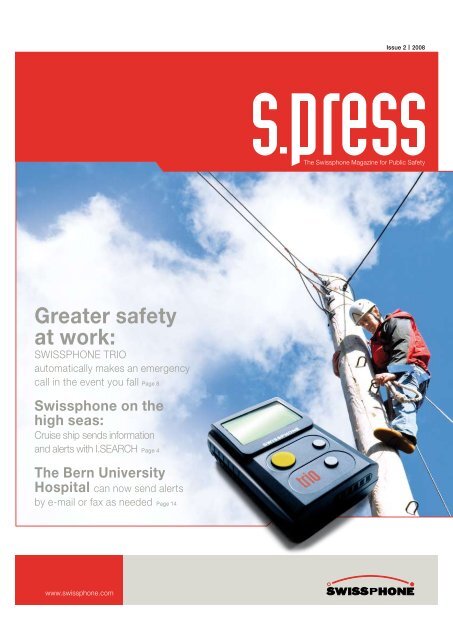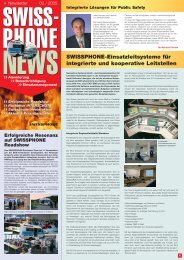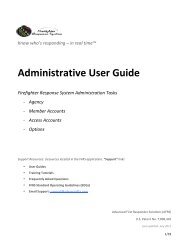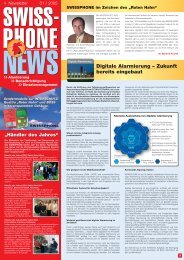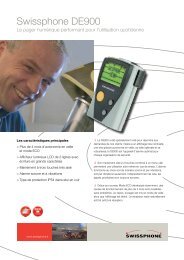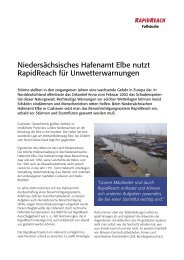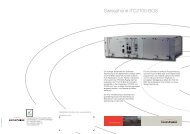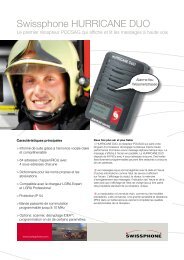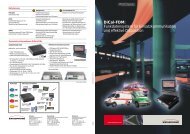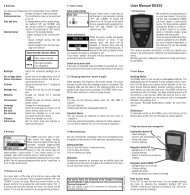Greater safety at work: - Swissphone
Greater safety at work: - Swissphone
Greater safety at work: - Swissphone
You also want an ePaper? Increase the reach of your titles
YUMPU automatically turns print PDFs into web optimized ePapers that Google loves.
<strong>Gre<strong>at</strong>er</strong> <strong>safety</strong><br />
<strong>at</strong> <strong>work</strong>:<br />
SWISSPHONE TRIO<br />
autom<strong>at</strong>ically makes an emergency<br />
call in the event you fall Page 8<br />
<strong>Swissphone</strong> on the<br />
high seas:<br />
Cruise ship sends inform<strong>at</strong>ion<br />
and alerts with I.SEARCH Page 4<br />
The Bern University<br />
Hospital can now send alerts<br />
by e-mail or fax as needed Page 14<br />
www.swissphone.com<br />
Issue 2 | 2008<br />
The <strong>Swissphone</strong> Magazine for Public Safety
INSIDE<br />
CONTENTS<br />
Editorial 0 3<br />
PRODUCTS<br />
<strong>Swissphone</strong> on the Mediterranean:<br />
Cruise ship can provide discreet<br />
inform<strong>at</strong>ion using I.SEARCH 04<br />
secur.TPA is the new <strong>Swissphone</strong> system<br />
for tactically alerting specific people 06<br />
<strong>Gre<strong>at</strong>er</strong> <strong>safety</strong> <strong>at</strong> <strong>work</strong>:<br />
SWISSPHONE TRIO combines GSM<br />
and GPS technology in one handy device 08<br />
SOLUTIONS<br />
The multimaster concept stands for<br />
fast regional alerting 10<br />
The Fire Brigade in Ardèche tests the<br />
new functions of RES.Q 12<br />
The emergency response centre of<br />
the Bern University Hospital now has an<br />
efficient alert system 14<br />
SOLUTIONS<br />
The Red Cross in Esslingen-<br />
Nürtingen moves into new rescue<br />
services control centre 16<br />
New <strong>work</strong>st<strong>at</strong>ions for the integr<strong>at</strong>ed<br />
North-East control center in Brandenburg 16<br />
Control center vehicles of<br />
Oberbergischer Kreis obtain new<br />
communic<strong>at</strong>ion software 17<br />
BACKGROUND<br />
“Maintaining the quality standard is<br />
more important than certific<strong>at</strong>ion itself” 18<br />
EVENTS<br />
<strong>Swissphone</strong> on the move 20
Helmut Köchler,<br />
President of the Board<br />
EDITORIAL<br />
Dear business partners and customers,<br />
If you use “only” redundant systems you can miss out<br />
on three goals – which is wh<strong>at</strong> happened during<br />
the blackout of the EURO 2008 semi-final m<strong>at</strong>ch when<br />
Germany be<strong>at</strong> Turkey 3 to 2. Had the game not<br />
gone into overtime, many parts of Europe would have<br />
even missed the final moments of the m<strong>at</strong>ch.<br />
Modern communic<strong>at</strong>ion systems are complex and<br />
the extent to which they can be made secure through<br />
redundancy is limited.<br />
In a life and de<strong>at</strong>h situ<strong>at</strong>ion alert systems without<br />
redundancy represent a weak link. In the past, church<br />
bells were used as a secondary and independent<br />
communic<strong>at</strong>ion system in addition to sirens. With<br />
the introduction of paging technology, sirens were<br />
only used as a secondary system for a long time.<br />
Yet nobody wants to use sirens for alerts anymore.<br />
Where does the future of the secondary independent<br />
alert system now lie?<br />
In Switzerland the alert system is based on two<br />
separ<strong>at</strong>e communic<strong>at</strong>ion channels. In the past and<br />
partly today, people are alerted over the telephone<br />
and separ<strong>at</strong>ely via paging. Various cantons in<br />
Switzerland have now discarded telephone-based<br />
02 | 03<br />
alerts and replaced them with a second, separ<strong>at</strong>e<br />
paging net<strong>work</strong>. The alarm end devices have two<br />
receivers, both of which can receive messages over<br />
radio net<strong>work</strong>s and can thus always be alerted<br />
on the secondary system in the event of a system<br />
failure.<br />
With its new alarm device, RES.Q, <strong>Swissphone</strong> is even<br />
better equipped to provide for future fail-proof alerts.<br />
If only one radio transmission net<strong>work</strong> is available<br />
then, in case of failure of this net<strong>work</strong> the GSM<br />
module for GPRS messages can be activ<strong>at</strong>ed as a<br />
back-up solution. However, if it is a m<strong>at</strong>ter of<br />
alarming, no alarm system channel is safe however<br />
redundant it is. RES.Q combines paging and modern<br />
“church bells” into a single system.<br />
For more inform<strong>at</strong>ion on the RES.Q terminal, read<br />
pages 12 and 13.<br />
I hope you find this newsletter an interesting read.<br />
Helmut Köchler<br />
The <strong>Swissphone</strong> Magazine for Public Safety
PRODUCTS<br />
<strong>Swissphone</strong> on board:<br />
The Costa Classica cruise ship<br />
uses I.SEARCH to send inform<strong>at</strong>ion and alerts<br />
Easy, quick and total coverage: These were the requirements of the internal communic<strong>at</strong>ion system<br />
th<strong>at</strong> the crew of the Costa Classica cruise ship wanted to use. Aside from quick communic<strong>at</strong>ion<br />
throughout the entire ship, I.SEARCH also provides an efficient and discreet means of sending alerts.<br />
The Costa Classica cruise ship is owned by the Italian<br />
company Costa Crociere S.p.A, which is based<br />
in Genoa. The company commands a fleet of 19<br />
cruise ships, which sail through the Mediterranean,<br />
off the coast of Northern Europe, in the Caribbean,<br />
around Central America, South America, the<br />
Arab Emir<strong>at</strong>es, the Far East and the Indian Ocean.<br />
I.SEARCH informs, alerts and searches<br />
The Costa Classica was built in 1991 and oper<strong>at</strong>es<br />
in the Mediterranean. It can carry 1680 passengers<br />
along with a crew of 590. The cruise ship has 13<br />
decks with a total length of about 220 meters and<br />
a width of about 30 meters.<br />
Author: P<strong>at</strong>rick Utzinger · Product Manager, Business Unit Systems & Net<strong>work</strong>s, <strong>Swissphone</strong> Telecom AG,<br />
Samstagern, Switzerland
In order to offer a calm and pleasant Mediterranean<br />
voyage and <strong>at</strong>tend to guests in a courteous<br />
manner, fast communic<strong>at</strong>ion among staff is essential.<br />
On a ship it is also particularly important th<strong>at</strong><br />
specialist crew members can get to their assigned<br />
st<strong>at</strong>ions quickly, directly and discreetly in an emergency.<br />
For minor incidents, the ship’s organisers do<br />
not want to disturb the guests, but if a serious<br />
emergency arises, then passengers must be brought<br />
to <strong>safety</strong> as quickly as possible. With I.SEARCH,<br />
the modular system for communic<strong>at</strong>ion, alerting and<br />
people searching, Costa Classica can achieve three<br />
goals <strong>at</strong> once: fast communic<strong>at</strong>ion, discreet alerting<br />
and efficient people searching.<br />
Alerting via e-mail, SMS or pager<br />
I.SEARCH is integr<strong>at</strong>ed into both the existing IP<br />
net<strong>work</strong> and radio net<strong>work</strong> (antennas, leaky feeder)<br />
of the ship. The Costa Classica therefore has an<br />
early-warning, inform<strong>at</strong>ion and alert system in addition<br />
to a voice radio system. The relevant inform<strong>at</strong>ion<br />
can be received by e-mail, SMS and POCSAG pagers.<br />
04 | 05<br />
The autom<strong>at</strong>ic triggering of technical alerts is one of<br />
the key fe<strong>at</strong>ures of I.SEARCH. Fault messages can<br />
be viewed on the web user interface of I.SEARCH.<br />
When combined with “dynamic grouping”, the<br />
emergency crews assigned to a specific alert group<br />
can be mobilised in due time – regardless of where<br />
they are on the ship.<br />
Even mobile crew members are easily accessible<br />
For crew members with changing st<strong>at</strong>ions such as<br />
caretakers, electricians or service personnel,<br />
accessibility over a large area represents a serious<br />
challenge. When combined with the telephone<br />
switchboard of the Costa Classica, I.SEARCH<br />
becomes a convenient people search system.<br />
Using I.SEARCH’s web user interface or an e-mail<br />
program on any PC on the ship you can send the<br />
appropri<strong>at</strong>e pager or SMS messages. This allows you<br />
to reach and inform mobile crew members as well.<br />
The <strong>Swissphone</strong> Magazine for Public Safety
PRODUCTS<br />
secur.TPA –<br />
a new system for tactically<br />
alerting people<br />
<strong>Swissphone</strong> Systems GmbH recently introduced its new alert system “secur.TPA” to the market.<br />
“secur.TPA” fe<strong>at</strong>ures the ability to trigger alerts and notific<strong>at</strong>ions for emergency personnel from an<br />
easy-to-use PC interface.<br />
The system is based on a d<strong>at</strong>abase or interface server<br />
which is connected to the PC <strong>work</strong>st<strong>at</strong>ions of the<br />
alert centre. With “secur.TPA” (tactical person alert)<br />
you can trigger alerts using a PC interface or other<br />
communic<strong>at</strong>ion channels. Once you enter the incident<br />
loc<strong>at</strong>ion and cause on the PC, the appropri<strong>at</strong>e<br />
personnel for the incident will be alerted based on<br />
stored d<strong>at</strong>a. Different alert channels can be selected<br />
for each staff member. These channels include,<br />
for example, pager alerts via a digital radio net<strong>work</strong><br />
and voice texts to a landline or mobile telephone,<br />
or SMS messages.<br />
Author: Günter Rapp · Division Manager of Product Management, <strong>Swissphone</strong> Systems GmbH, Stuttgart, Germany
Handling confirm<strong>at</strong>ions<br />
From an oper<strong>at</strong>ive/tactical point of view, it is always<br />
best if the alerted individuals are able to respond<br />
to the alert directly. This ensures th<strong>at</strong> the disp<strong>at</strong>cher<br />
will quickly know whether a follow-up alert is<br />
necessary in order to reach the required number of<br />
emergency personnel. The “secur.TPA” system<br />
autom<strong>at</strong>ically processes incoming confirm<strong>at</strong>ions. If<br />
someone is notified by telephone, they can report<br />
their st<strong>at</strong>us to the system by pressing the appropri<strong>at</strong>e<br />
button. For example: 1 = I'm coming or 2 = I'm not<br />
coming. The outgoing alerts and incoming confirm<strong>at</strong>ions<br />
are then grouped on the user interface of<br />
“secur.TPA”.<br />
RES.Q means no longer having to use the<br />
telephone as a backup<br />
The new <strong>Swissphone</strong> RES.Q alert terminal represents<br />
a giant step forwards in optimising the alert<br />
The Canton Hospital of<br />
Graubünden will use “secure.TPA” to<br />
send alerts<br />
06 | 07<br />
In the Canton Hospital of Graubünden, which is<br />
based in Chur, “secure.TPA” is deployed on servers<br />
and <strong>work</strong>st<strong>at</strong>ions in two separ<strong>at</strong>e loc<strong>at</strong>ions th<strong>at</strong><br />
are connected over a net<strong>work</strong>. As a result, staff members<br />
can immedi<strong>at</strong>ely start to <strong>work</strong> <strong>at</strong> the other<br />
loc<strong>at</strong>ion when an emergency incident occurs.<br />
Alerts in the Canton Hospital of Graubünden are<br />
not only performed for internal incidents, but<br />
also in the event th<strong>at</strong> a large number of p<strong>at</strong>ients<br />
are expected (e.g., a bus accident). The alerts<br />
and notific<strong>at</strong>ions are sent to the appropri<strong>at</strong>e personnel<br />
using a variety of communic<strong>at</strong>ion channels<br />
such as the people search system, telephones<br />
(internal/external), pagers and mobile telephones.<br />
Redundant system design for the<br />
Canton Police Department in Appenzell<br />
The Canton Police Department in Appenzell Innerrhoden<br />
and Ausserrhoden uses a redundant system<br />
based on “secur.TPA”, which means it is used<br />
in the two emergency centres in Appenzell and<br />
Trogen. Different communic<strong>at</strong>ion channels are<br />
used to send alerts. The primary channel is based<br />
on pager alerting, while telephone alerting is<br />
used as a secondary channel. SMS messages can<br />
also be used when needed.<br />
procedure and a breakthrough innov<strong>at</strong>ion. When<br />
using this new <strong>Swissphone</strong> device, an alerted person<br />
does not need to use a telephone to confirm, but<br />
can do so directly with the RES.Q terminal. This<br />
makes it possible to receive confirm<strong>at</strong>ion over<br />
a radio alert – without having to rely on telephone<br />
alerting. As a result, emergency personnel do<br />
not have to use an additional communic<strong>at</strong>ion device<br />
to send confirm<strong>at</strong>ions. The RES.Q terminal can<br />
furthermore be used to send confirm<strong>at</strong>ions to the<br />
oper<strong>at</strong>ions control centre securely and quickly.<br />
In Switzerland, “secur.TPA” offers an altern<strong>at</strong>ive to<br />
the system where emergency personnel are mobilised<br />
by telephone. It furthermore meets all the requirements<br />
of the “Fire Service 2000 plus” plan.<br />
In addition, the entire text transmission can be<br />
encrypted with the IDEA system.<br />
The <strong>Swissphone</strong> Magazine for Public Safety
PRODUCTS<br />
Be on the safe side<br />
with SWISSPHONE<br />
Lawmakers must guarantee th<strong>at</strong> all employees are able to receive immedi<strong>at</strong>e help in the event of<br />
an accident, particularly if their <strong>work</strong> takes them to remote and isol<strong>at</strong>ed loc<strong>at</strong>ions. This also applies to<br />
areas where GPS signals cannot be received. <strong>Swissphone</strong>'s answer to this problem is TRIO.<br />
From the control centre to the terminal via the net<strong>work</strong>:<br />
<strong>Swissphone</strong> offers perfectly configured<br />
emergency call components and can therefore<br />
provide customised solutions for the field of<br />
“occup<strong>at</strong>ional <strong>safety</strong>”. The l<strong>at</strong>est <strong>Swissphone</strong><br />
innov<strong>at</strong>ion in this area is TRIO DE955-GP.<br />
This personal emergency call system combines<br />
the l<strong>at</strong>est GSM and GPS technology in one handy<br />
device.<br />
Autom<strong>at</strong>ic emergency call after a fall<br />
The compact and durable <strong>Swissphone</strong> TRIO fe<strong>at</strong>ures<br />
an emergency call button th<strong>at</strong> an employee can<br />
press to trigger an emergency call should a dangerous<br />
situ<strong>at</strong>ion arise. In addition to the emergency call,<br />
geographical d<strong>at</strong>a is transmitted and displayed on a<br />
map in the control centre. TRIO can also send an<br />
emergency signal to the control centre if the carrier<br />
Author: Oliver Schätti · Product Manager, Business Unit Mobile Solutions & Services, <strong>Swissphone</strong> Telecom AG,<br />
Samstagern, Switzerland
of the device falls or shows no movement after a set<br />
period of time. In such cases the integr<strong>at</strong>ed<br />
position, movement and acceler<strong>at</strong>ion sensors send<br />
an emergency signal autom<strong>at</strong>ically.<br />
In addition, TRIO can be set up to trigger a pre-alert<br />
after a specific time interval elapses. The employee<br />
can both see and hear this alert and must confirm it<br />
by pressing the appropri<strong>at</strong>e button. If the pre-alert<br />
is not confirmed after a specific period of time, an<br />
alarm will be autom<strong>at</strong>ically triggered in the control<br />
centre. The device also fe<strong>at</strong>ures geofencing, which<br />
signals the control centre as to whether a previously<br />
defined area is entered or exited.<br />
Periodic connection check<br />
All communic<strong>at</strong>ion between TRIO and the control<br />
centre is based on GSM technology. If an employee<br />
enters an area where the connection to a GSM<br />
antenna is lost and hence an emergency call cannot<br />
be sent, both the carrier and the control centre will<br />
be notified of this. The end device can be configured<br />
to transmit a st<strong>at</strong>us report to the control centre<br />
<strong>at</strong> regular intervals. Besides inform<strong>at</strong>ion on the<br />
b<strong>at</strong>tery charge level and oper<strong>at</strong>ional st<strong>at</strong>us of the<br />
device, the quality of the connection is also displayed<br />
in the control centre.<br />
Also with “in-house” positioning<br />
08 | 09<br />
In areas, channels or buildings where GPS or GSM<br />
signal reception is limited or unavailable, st<strong>at</strong>ionary<br />
and b<strong>at</strong>tery-powered <strong>Swissphone</strong> positioning<br />
transmitters can be installed easily. Another option<br />
is to increase the GSM reception range by installing<br />
additional antennas. This ensures th<strong>at</strong> the new<br />
personal emergency call system can be reached in<br />
areas where GSM coverage is not available.<br />
Key functions <strong>at</strong> a glance<br />
Emergency call functions with GSM<br />
Positioning with GPS and/or positioning<br />
transmitter<br />
Manual alerting by pushing an SOS button<br />
Autom<strong>at</strong>ic emergency detection via position,<br />
movement and acceler<strong>at</strong>ion sensors<br />
Communic<strong>at</strong>ion by means of GSM and/or paging<br />
Web tool for geographical positioning<br />
Easy integr<strong>at</strong>ion into existing oper<strong>at</strong>ions control<br />
systems<br />
The <strong>Swissphone</strong> Magazine for Public Safety
SOLUTIONS<br />
Multimaster guarantees<br />
efficient and secure transmission<br />
of alarms on a regional level<br />
The Multimaster concept by <strong>Swissphone</strong> consolid<strong>at</strong>es multiple alert zones into one region while retaining<br />
the alert time of each zone. Alerts are transmitted quickly, efficiently and securely across the area thanks<br />
to a master-slave configur<strong>at</strong>ion.<br />
In the Multimaster concept, master base st<strong>at</strong>ions form<br />
the centre of a zone and are surrounded by slave<br />
base st<strong>at</strong>ions, which are positioned in such a way<br />
th<strong>at</strong> they transmit alert notific<strong>at</strong>ions in the form of<br />
a wave. Precise control of wave distribution enables<br />
even topologically complex areas to be reached<br />
efficiently and ensures th<strong>at</strong> no inform<strong>at</strong>ion is lost when<br />
alert notific<strong>at</strong>ions are sent.<br />
High availability<br />
<strong>Swissphone</strong> supplies its own system components so<br />
th<strong>at</strong> the Multimaster concept can be set up in a<br />
modular fashion. These include: the master base<br />
st<strong>at</strong>ions and the paging net<strong>work</strong> controller (PNC)<br />
with redundant design and the feed lines to the<br />
master with parallel running transmission media such<br />
as radio links and fixed-line net<strong>work</strong> connections<br />
(the l<strong>at</strong>ter are supplied by net<strong>work</strong> providers). The<br />
high availability of the system is facilit<strong>at</strong>ed by<br />
having the slave base st<strong>at</strong>ions set up so th<strong>at</strong> the radio<br />
signals overlap individual geographical areas.<br />
Flexible triggering of alerts<br />
Author: Alfred Schärli · Head of Business Unit Systems & Net<strong>work</strong>s, <strong>Swissphone</strong> Telecom AG,<br />
Samstagern, Switzerland<br />
If necessary, alerts can also be triggered locally by<br />
connecting terminals to the master base st<strong>at</strong>ion.<br />
This can be useful if a control centre needs to be<br />
moved temporarily due to a specific incident, or if<br />
the redundant connections from the computer-aided<br />
disp<strong>at</strong>ch system to the master base st<strong>at</strong>ions fail.<br />
Local alerts are also possible by connecting a terminal<br />
to a slave base st<strong>at</strong>ion. Moreover, TETRA-POCSAG
Loc<strong>at</strong>ion A Loc<strong>at</strong>ion B Net<strong>work</strong> Feeder Region with optimal coverage<br />
<strong>Swissphone</strong><br />
products<br />
Oper<strong>at</strong>ions<br />
control centre<br />
secur.CAD<br />
Digicom<br />
I.SEARCH<br />
Third-party<br />
products<br />
Oper<strong>at</strong>ions<br />
control centre<br />
CAD<br />
PNMS<br />
Redundant<br />
paging<br />
net<strong>work</strong><br />
controller<br />
(PNC)<br />
g<strong>at</strong>eways enable the triggering of alarms from a<br />
TETRA terminal. In this case, alerts within the<br />
TETRA zone are transmitted with POCSAG paging<br />
technology.<br />
Fall back oper<strong>at</strong>ion mode via the master<br />
base st<strong>at</strong>ion<br />
PSTN<br />
VPN<br />
The Multimaster net<strong>work</strong> is capable of running independently<br />
and does not have to rely on thirdparty<br />
systems. If, in an emergency oper<strong>at</strong>ion scenario,<br />
the IP connection to one or more master base<br />
st<strong>at</strong>ions fails or the time reference malfunctions,<br />
inform<strong>at</strong>ion is sent throughout the area using the<br />
unaffected master st<strong>at</strong>ions. Inform<strong>at</strong>ion on the fall<br />
back oper<strong>at</strong>ion mode is passed from the PNC<br />
to these master base st<strong>at</strong>ions via the air interface.<br />
The master base st<strong>at</strong>ions transmit the “fall back<br />
oper<strong>at</strong>ion” inform<strong>at</strong>ion within the current alert notific<strong>at</strong>ion<br />
to the slave base st<strong>at</strong>ions, which then<br />
also switch to fall back oper<strong>at</strong>ion mode for alert<br />
broadcasting.<br />
Master<br />
Urban<br />
centre<br />
Master<br />
Master<br />
Paging Net<strong>work</strong> Management System<br />
Continuous net<strong>work</strong> monitoring<br />
Slave<br />
Pager<br />
Slave<br />
10 | 11<br />
To monitor net<strong>work</strong> oper<strong>at</strong>ion, a convenient paging<br />
net<strong>work</strong> management system (PNMS) is available.<br />
Inform<strong>at</strong>ion on the st<strong>at</strong>us of the master and slave<br />
base st<strong>at</strong>ions is periodically checked via the air<br />
interface and accessible <strong>at</strong> all times. This cyclical<br />
radio coverage ensures th<strong>at</strong> radio frequency site<br />
surveys are performed over the entire area. All base<br />
st<strong>at</strong>ions can be configured using PNMS.<br />
In addition, monitor receivers in an area can be<br />
positioned so th<strong>at</strong> specific sub-areas of the zone are<br />
permanently monitored. During construction and<br />
install<strong>at</strong>ion <strong>work</strong>, net<strong>work</strong> adjustments can be configured<br />
and controlled via the GSM modem in the<br />
base st<strong>at</strong>ions.<br />
High security paging<br />
POCSAG inform<strong>at</strong>ion intended for secure transmission<br />
is protected by IDEA encryption (“intern<strong>at</strong>ional<br />
d<strong>at</strong>a encryption algorithms”) en route to the alert<br />
terminals. Our sophistic<strong>at</strong>ed plan for regularly<br />
changing encryption keys ensures a high level of<br />
transmission security.<br />
The <strong>Swissphone</strong> Magazine for Public Safety
SOLUTIONS<br />
The Fire and Rescue Service in Ardèche<br />
is testing RES.Q<br />
The Ardèche fire brigade has about 2500 fire fighters,<br />
2350 of whom are volunteers, who are spread<br />
out over 76 local fire and rescue st<strong>at</strong>ions. They are<br />
supported by 63 administr<strong>at</strong>ive and technical staff<br />
members. The Mayor and Prefect of Ardèche are<br />
responsible for the administr<strong>at</strong>ive branch of the<br />
police and, in particular, for the protection of persons<br />
and property. The affili<strong>at</strong>ed fire and rescue<br />
service of Ardèche (SDIS) is a public institution with<br />
the mand<strong>at</strong>e to provide all the m<strong>at</strong>erial and personnel<br />
resources necessary to ensure the <strong>safety</strong> and<br />
protection of the local popul<strong>at</strong>ion.<br />
Author: Lieutenant Colonel Alain Soubrillard · Fire and Rescue Service of the Ardèche Department, France
Equipped with <strong>Swissphone</strong> pagers<br />
Since spring 1996, all calls to the respective departments<br />
under the numbers 18 and 112 have been<br />
received by the alert centre in Privas. At th<strong>at</strong> time the<br />
alert receivers of the fire brigade were paid by the<br />
individual communities and hence the number of<br />
receivers was very limited. In 2001 the SDIS Ardèche<br />
decided to supplement the alert receivers by<br />
equipping each fire and rescue st<strong>at</strong>ion with additional<br />
pagers. As a result, the total number of personnel<br />
with pagers increased to 80 per cent in 2004. In 2005<br />
the alert system was converted to alerting the fire<br />
brigade with alert receivers based on the POCSAG<br />
standard. Over the following two years the SDIS<br />
Ardèche purchased pagers from <strong>Swissphone</strong> in order<br />
to equip all available personnel. This year SDIS<br />
Ardèche also replaced all devices th<strong>at</strong> were over eight<br />
years old with new digital <strong>Swissphone</strong> devices of<br />
the DE series.<br />
Alerting, confirm<strong>at</strong>ion and positioning all in one<br />
Thanks to the GSM/GPRS module integr<strong>at</strong>ed into the<br />
new RES.Q alert terminal, the recipient of an alert<br />
can now send a confirm<strong>at</strong>ion as to whether or not he<br />
or she can take part in an oper<strong>at</strong>ion. This allows<br />
the incident manager to know <strong>at</strong> once how many<br />
emergency personnel will actually respond to the<br />
incident and, when neg<strong>at</strong>ive confirm<strong>at</strong>ions are received,<br />
they can autom<strong>at</strong>ically request or mobilise<br />
further emergency personnel. This confirm<strong>at</strong>ion<br />
functionality facilit<strong>at</strong>es the comprehensive and fast<br />
management of emergency personnel. It also<br />
prevents the mobilis<strong>at</strong>ion of unnecessary resources<br />
and thus elimin<strong>at</strong>es the associ<strong>at</strong>ed costs.<br />
Optimal alert management with RES.Q<br />
12 | 13<br />
The RES.Q terminal, which has just been released<br />
onto the market, can be used to help organise<br />
volunteer fire fighter availability and personnel administr<strong>at</strong>ion<br />
in an optimal manner. RES.Q allows<br />
both the delivery of tactical confirm<strong>at</strong>ions and the<br />
positioning of emergency personnel, which in<br />
turn leads to extremely efficient personnel management<br />
(see sidebar).<br />
Over the next few months, a group specialising in<br />
search and rescue missions in dangerous areas and<br />
whose members are distributed through the entire<br />
department will conduct a pilot test with RES.Q.<br />
With the optional built-in GPS module, RES.Q can<br />
localise emergency personnel or determine how<br />
far they are from a reference point. This distance comparison<br />
not only indic<strong>at</strong>es how quickly a person<br />
can reach an incident loc<strong>at</strong>ion, but also makes it<br />
possible to perform zone alerting or geographic<br />
alerts. Zone alerting allows precisely those personnel<br />
to be alerted who are loc<strong>at</strong>ed in the proposed<br />
oper<strong>at</strong>ional area. On d<strong>at</strong>a protection grounds the<br />
coordin<strong>at</strong>es of the precise whereabouts of the<br />
emergency personnel are not transmitted to the<br />
control centre. However, the control centre knows<br />
the zone in which the emergency personnel are<br />
situ<strong>at</strong>ed.<br />
The <strong>Swissphone</strong> Magazine for Public Safety
SOLUTIONS<br />
Bern University Hospital:<br />
secur.CAD makes efficient<br />
alerting possible<br />
<strong>Swissphone</strong> has equipped Bern University Hospital with a professional computer-aided disp<strong>at</strong>ch<br />
system. The new system can be used to send alerts through a variety of communic<strong>at</strong>ion channels<br />
such e-mail or fax.
Bern University Hospital is one of the most important<br />
university hospitals in Switzerland.<br />
It employs around 6,000 people and tre<strong>at</strong>s over<br />
220,000 p<strong>at</strong>ients every year. The hospital's alert<br />
centre or emergency response centre receives all<br />
incident reports around the clock for fire service<br />
members, service technicians and security personnel.<br />
New computer-aided disp<strong>at</strong>ch system<br />
To make it easier for emergency response centre<br />
personnel to alert and process incidents, the centre<br />
is being equipped with the “secur.CAD” computeraided<br />
disp<strong>at</strong>ch system. Alerts rel<strong>at</strong>ing to medical and<br />
technical needs as well as <strong>safety</strong> are now processed<br />
in the new system.<br />
In the past, emergency incidents were handled<br />
manually based on action plans. Internal alerting was<br />
performed using a people search system, while<br />
external alerting was performed using a “mobilise<br />
by telephone system” oper<strong>at</strong>ed by the regional<br />
incident control centre of the Canton police department<br />
in Berne.<br />
Alerting via all communic<strong>at</strong>ion channels<br />
“secur.CAD” enables the professional handling of<br />
incidents based on predefined scenarios as well as<br />
the tiered internal and external alerting of relevant<br />
st<strong>at</strong>ions over all existing communic<strong>at</strong>ion channels.<br />
The current systems in use such as the building<br />
control system, the people search system and the<br />
telephone switchboard are integr<strong>at</strong>ed into the<br />
Author: Angelika Maier · Marketing, <strong>Swissphone</strong> Systems GmbH,<br />
Stuttgart, Germany<br />
14 | 15<br />
computer-aided disp<strong>at</strong>ch system, as well as all e-mail<br />
or fax for external alerting. The new system also<br />
includes a module for tactical telephone alerting:<br />
group alerts can now be triggered for major incidents.<br />
Autom<strong>at</strong>ic alerting possible<br />
In addition to the usual manual alerting procedure,<br />
which requires disp<strong>at</strong>chers to process incidents,<br />
“secur.CAD” also offers autom<strong>at</strong>ic alerting. If, for<br />
example, sensors or measuring instruments detect<br />
a fire or the fact th<strong>at</strong> a specific threshold value<br />
has been exceeded, “secur.CAD” autom<strong>at</strong>ically<br />
initi<strong>at</strong>es the procedures and actions of emergency<br />
personnel without requiring any input from a<br />
disp<strong>at</strong>cher.<br />
New alerting reduces human <strong>work</strong>load<br />
This new technology ensures th<strong>at</strong> there is significantly<br />
more capacity available for alerts and th<strong>at</strong> <strong>safety</strong><br />
personnel can be accessed faster. Moreover, the<br />
<strong>work</strong>load of employees <strong>at</strong> the alert centre, who<br />
are also responsible for manning the emergency<br />
response centre and both the telephone switchboard<br />
and p<strong>at</strong>ient admissions <strong>at</strong> night, is effectively reduced.<br />
In May 2008, the system passed its first factory<br />
acceptance test. Officials <strong>at</strong> Bern University Hospital<br />
called the test a success and confirmed full<br />
acceptance without reserv<strong>at</strong>ions.<br />
The <strong>Swissphone</strong> Magazine for Public Safety
SOLUTIONS<br />
New Rescue Services Control Centre in Esslingen<br />
At the end of May 2008, the emergency service of<br />
the German Red Cross of Esslingen-Nürtingen<br />
moved into its new control centre in Esslingen.<br />
<strong>Swissphone</strong> Systems GmbH was tasked with<br />
equipping the new control centre with the “secure.<br />
CAD” system and providing technical support<br />
during the transition. All control centre oper<strong>at</strong>ions<br />
had to be maintained during the entire move: all<br />
calls and emergency calls had to be received and<br />
processed.<br />
Seamless transition<br />
On the day of the move, both the old and the new<br />
control centres were manned from 9 a.m. to 12 p.m.<br />
Calls to the old site were received and then transferred<br />
to the new site, where oper<strong>at</strong>ions were then<br />
<strong>Swissphone</strong> Systems GmbH won the bid to equip<br />
the new North-East regional control centre<br />
in Brandenburg, Germany, with the “secur.CAD”<br />
computer-aided disp<strong>at</strong>ch system. This project requires<br />
a number of hardware install<strong>at</strong>ions and the integr<strong>at</strong>ion<br />
of subsystems such as audio-visual equipment,<br />
for example. A comprehensive security concept will<br />
be implemented as well.<br />
Fast and effective when it m<strong>at</strong>ters most<br />
The integr<strong>at</strong>ed regional control centre merges three<br />
different incident control centres loc<strong>at</strong>ed in the rural<br />
handled. After all d<strong>at</strong>a was transferred from the old<br />
system to the new one, the telephone lines were<br />
switched over by the phone company. This allowed<br />
a seamless transition within a short period of time.<br />
Four new oper<strong>at</strong>ions control st<strong>at</strong>ions<br />
The new rescue services control centre is equipped<br />
with four oper<strong>at</strong>ions control st<strong>at</strong>ions, an emergency<br />
call st<strong>at</strong>ion as well as two system support st<strong>at</strong>ions.<br />
The software includes the new “bed availability”<br />
and “appointment calendar” modules. The following<br />
subsystems were also integr<strong>at</strong>ed into the control<br />
centre: Radio-wired exchange, analogue 5-tone<br />
follow-up alerts, POCSAG digital alerts, voice document<strong>at</strong>ion,<br />
and office communic<strong>at</strong>ion applic<strong>at</strong>ions.<br />
Integr<strong>at</strong>ed regional control centre<br />
includes 28 <strong>work</strong>st<strong>at</strong>ions<br />
districts of Barnim, Oberhavel and Uckermark and<br />
places them under a joint command structure.<br />
A total of 28 <strong>work</strong>st<strong>at</strong>ions need to be set up for this<br />
large-scale project. The current version (4.3) of<br />
the “secur.CAD” software is the ideal choice as it<br />
contains all the functions and modules necessary<br />
to fulfil the tasks of the integr<strong>at</strong>ed North-East regional<br />
control centre. “secur.CAD” enables fast and secure<br />
alerting and the effective handling of major incidents<br />
in the field offices of the three districts.
Oberbergischer Kreis:<br />
New system for communic<strong>at</strong>ion<br />
between vehicles and control centre<br />
In Marienheide, Germany, <strong>Swissphone</strong> Systems<br />
GmbH is equipping 23 rescue service vehicles of<br />
the district control centre in Oberbergischer Kreis<br />
with the mobile MPC vehicle communic<strong>at</strong>ion system<br />
and the “secur.mobile” software. Two-way<br />
communic<strong>at</strong>ion between the vehicles and the control<br />
centre is based on GSM/GPRS and is performed<br />
via the <strong>Swissphone</strong> DiCal radio d<strong>at</strong>a module FDM<br />
District control<br />
centre<br />
<strong>Swissphone</strong> MPC<br />
(Mobile PC) for use in vehicles<br />
Author: Angelika Maier · Marketing, <strong>Swissphone</strong> Systems GmbH,<br />
Stuttgart, Germany<br />
16 | 17<br />
connection. An electronic device is also integr<strong>at</strong>ed<br />
for recording p<strong>at</strong>ient d<strong>at</strong>a and processing logs<br />
provided by emergency doctors. The overall concept<br />
calls for the cre<strong>at</strong>ion of a universal d<strong>at</strong>a exchange<br />
structure between “control centre – vehicles –<br />
accounting”, which leads to a significant improvement<br />
in quality: error sources arising from multiple d<strong>at</strong>a<br />
entries on various devices are avoided.<br />
Voice radio<br />
Device for recording<br />
p<strong>at</strong>ient d<strong>at</strong>a<br />
Bi-directional<br />
d<strong>at</strong>a exchange<br />
via GPRS for RMS<br />
st<strong>at</strong>us (RMS = radio<br />
messaging system)<br />
Sending and<br />
receiving BOS analogue<br />
radio transmissions<br />
GPS reception<br />
GSM/GPRS<br />
dual antenna, GPS,<br />
4m, 2 m<br />
The <strong>Swissphone</strong> Magazine for Public Safety
BACKGROUND<br />
“Certific<strong>at</strong>ion is first and foremost a<br />
confidence builde”<br />
Werner Schär,<br />
Director of Quality<br />
Management<br />
S w i s s p h o n e q u a l i t y m a n a g e m e n t s y s t e m : I S O 9 0 0 1 : 2 0 0 0 I Q N e t I S O 9 0 0 1 S w i s s Te s t i n g S T S 0 1 8 94/9 EG Directive WEEE Directives<br />
A successful company has to offer products and services th<strong>at</strong> meet customer expect<strong>at</strong>ions.<br />
To ensure th<strong>at</strong> those expect<strong>at</strong>ions are met, <strong>Swissphone</strong> adheres to strict quality standards. For<br />
Werner Schär, Director of Quality Management, complying with those standards is even more<br />
important than certific<strong>at</strong>ion itself.<br />
Why does <strong>Swissphone</strong> value the ISO quality<br />
management system so highly?<br />
Werner Schär: A quality management system shapes<br />
how the company is organised and can be understood<br />
as a comprehensive management and infor-<br />
m<strong>at</strong>ion system. The system helps to continually<br />
improve inter-company <strong>work</strong>flows as well as increase<br />
customer s<strong>at</strong>isfaction. This is why running a company<br />
without a quality management system is almost<br />
unthinkable nowadays.<br />
Author: Gabriela Knobel · Corpor<strong>at</strong>e Communic<strong>at</strong>ions, <strong>Swissphone</strong> Telecom AG, Samstagern, Switzerland
Wh<strong>at</strong> are the real-world effects of such<br />
a system?<br />
Organis<strong>at</strong>ion and optimis<strong>at</strong>ion mean th<strong>at</strong> all <strong>work</strong>flows,<br />
from the time of initial customer contact<br />
to contract conclusion and ongoing customer<br />
support, are explicitly defined and described in<br />
a manual and adhered to <strong>at</strong> all times. This manual<br />
can basically be seen as the oper<strong>at</strong>ing instructions<br />
for <strong>Swissphone</strong>. It provides inform<strong>at</strong>ion on who<br />
executes which <strong>work</strong>flow and wh<strong>at</strong> resources are<br />
needed to complete th<strong>at</strong> <strong>work</strong>flow. These <strong>work</strong>flows<br />
are continuously evalu<strong>at</strong>ed and refined.<br />
How do you r<strong>at</strong>e the external benefits of a<br />
quality management system?<br />
The external benefits are often overr<strong>at</strong>ed; for instance,<br />
when certific<strong>at</strong>ion is used as a marketing tool for<br />
<strong>at</strong>tracting new customers. Quality today is no longer<br />
Quality standards <strong>at</strong> <strong>Swissphone</strong><br />
<strong>Swissphone</strong> is certified according to the<br />
ISO 9001:2000 standard and oblig<strong>at</strong>ed to maintain<br />
the quality associ<strong>at</strong>ed with th<strong>at</strong> standard.<br />
ISO certific<strong>at</strong>ion is also recognised worldwide: IQNet.<br />
The internal “Swiss Testing” centre is a government-accredited<br />
testing labor<strong>at</strong>ory. It is connected<br />
to the certific<strong>at</strong>ion area of the ISO Standard 9000.<br />
The same guidelines and any additional provisions<br />
of the EN 17025 apply. This intern<strong>at</strong>ional standard<br />
defines the general requirements for conducting<br />
inspections.<br />
<strong>Swissphone</strong> is certified in accordance with the<br />
94/9 EC Directive. This certific<strong>at</strong>ion is mand<strong>at</strong>ory<br />
for <strong>Swissphone</strong> to be able to produce devices<br />
used in areas with potentially explosive <strong>at</strong>mospheres<br />
(EX).<br />
18 | 19<br />
a competitive advantage: it is simply, and rightly,<br />
expected by the customer.<br />
Quality management (ISO 9000) is an intern<strong>at</strong>ionally<br />
recognised standard. The customer or supplier<br />
knows <strong>at</strong> first glance which organis<strong>at</strong>ional measures<br />
are taken by <strong>Swissphone</strong>. ISO certific<strong>at</strong>ion is a<br />
benefit insofar as it increases the confidence customers<br />
and government authorities have in the<br />
company.<br />
Which quality standard do you value the most<br />
<strong>at</strong> <strong>Swissphone</strong>?<br />
In my opinion the single most important quality<br />
standard is and will always be common sense;<br />
when combined with a “lived” quality management<br />
system, we can reach the goal of continuously<br />
improving performance and service.<br />
As of July 2006, the RoHS Directive (“restriction<br />
of the use of certain hazardous substances in<br />
electrical and electronic equipment”) prohibits the<br />
use of certain substances – including lead – in<br />
all new electric and electronic devices. All relevant<br />
<strong>Swissphone</strong> products and components fe<strong>at</strong>ure<br />
the RoHS logo.<br />
The WEEE Directives (“waste electrical and<br />
electronic equipment”) is intended to reduce the<br />
disposal of waste electrical and electronic equipment.<br />
Manufacturers must ensure the collection and<br />
recycling of such equipment. As of 2005, all relevant<br />
<strong>Swissphone</strong> receivers and charging devices<br />
comply with the WEEE Directives and are labelled<br />
accordingly.<br />
The <strong>Swissphone</strong> Magazine for Public Safety
EVENTS<br />
<strong>Swissphone</strong> on the move<br />
Agenda 2008/2009<br />
D<strong>at</strong>e Event Loc<strong>at</strong>ion Background inform<strong>at</strong>ion<br />
30 - 1 October SKYDD 2008 Stockholm (S) www.skydd.net<br />
2 - 4 October 115th N<strong>at</strong>ional Congress of<br />
French Fire Brigades Rennes (F) www.congres2008.pompiers.fr<br />
3 - 5 October Retter 2008 Wels (A) www.rettermesse.<strong>at</strong><br />
7 - 10 October Security Essen 2008 Essen (D) www.security-messe.de<br />
5 - 6 November Occup<strong>at</strong>ional Health and Safety in Switzerland Basel (CH) www.arbeits-sicherheit-schweiz.ch<br />
25 - 27 November PMRExpo 2008 Leipzig (D) www.pmrexpo.de<br />
27 - 29 March 2009 Civil Protec 2009 Bozen (I) www.civilprotec.it<br />
25 - 29 May 2009 Tetra World Congress 2009 Munich (D) www.tetraworldcongress.com<br />
IMPRINT<br />
Edited and published by:<br />
<strong>Swissphone</strong> Telecom AG<br />
Corpor<strong>at</strong>e Communic<strong>at</strong>ions<br />
Fälmisstrasse 21<br />
CH-8833 Samstagern<br />
Phone: +41447867770<br />
Fax: +41447867771<br />
info@swissphone.com<br />
www.swissphone.com<br />
Design<br />
D’ART Visuelle<br />
Kommunik<strong>at</strong>ion GmbH<br />
Adlerstrasse 41<br />
D-70199 Stuttgart<br />
hello@dart<strong>work</strong>.de<br />
www.dart<strong>work</strong>.de


